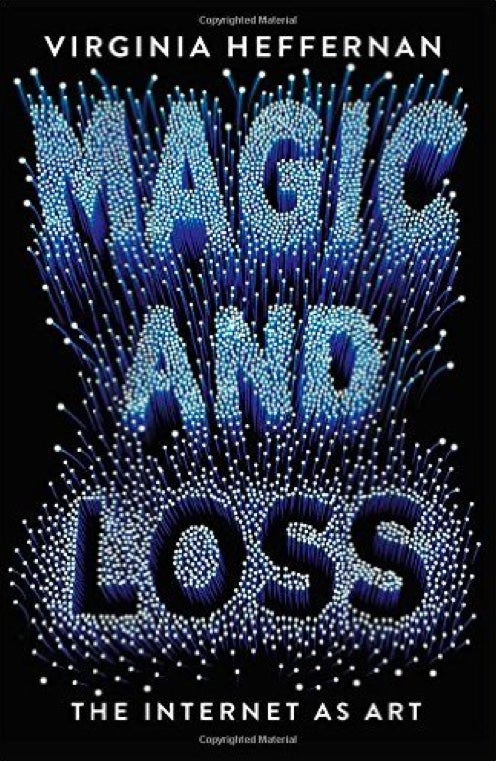 The internet links hundreds of millions of people to each other — and also to art in its myriad forms: music, video, pictures, text and so much more. It has helped people discover an inner creativity they might otherwise never have known they possessed. For author and former New York Times TV critic Virginia Heffernan, the internet is an art form of its own — a thesis she explores in her new book, Magic and Loss: The Internet as Art.
The internet links hundreds of millions of people to each other — and also to art in its myriad forms: music, video, pictures, text and so much more. It has helped people discover an inner creativity they might otherwise never have known they possessed. For author and former New York Times TV critic Virginia Heffernan, the internet is an art form of its own — a thesis she explores in her new book, Magic and Loss: The Internet as Art.
In the internet age, how we communicate has changed in extraordinary ways, and these shifts have only accelerated over time. Heffernan joined the Knowledge at Wharton Show on Sirius XM channel 111 to discuss ways our everyday language has evolved such that the medium really has become the message.
An edited transcript of the conversation follows.
Knowledge at Wharton: It is amazing how language, and how we talk and communicate with people, has changed remarkably within the last decade or two because of the influence of the internet and social media.
Virginia Heffernan: It’s extraordinary. As you said in your introduction, we are, almost without knowing it, making and consuming art. And by “we,” I mean the least likely people — the scientists, the businesspeople. Every time you post on Instagram, you are doing photography. You are distributing your photography; you are developing a photograph. You’re at times filtering and doctoring a photograph. That’s an art that people used to go to school for and really had to study. And yet we’ve all developed a knack for it.
Those of us who like Twitter also know how hard it is. You need the focus of a poet to get 140 characters to say something expressive and consequential. We don’t like to call it doing art. Maybe there’s something too twee about that. But we still are doing something that conforms to the rituals and patterns of making art.
Knowledge at Wharton: How much have these changes really taken away from language?
Heffernan: People love to decry the demise of language, but right now, we are in a period where language is proliferating. It used to seem that there would never be a brand new language. In fact, we’re seeing, first with emoticons and then with emoji — as you probably know, there are whole books now written in emoji — that we have a pictographic language that we are all inventing right now. Someone tried the other day to say, “Well, emoji just aren’t as expressive as the regular Roman letters we use.” And I thought, “Spoken like someone who has never had an emoji showdown on text!”
“Every time you post on Instagram, you are doing photography.… That’s an art that people used to go to school for and really had to study.”
Knowledge at Wharton: Realistically, I think it’s only going to get worse. Consider the change Facebook made recently to add emoji options as reactions to posts other than “liking” them. This is just going to ramp up.
Heffernan: Well, it’s only going to get worse or better. There’s nothing intrinsically worse or less literate about pictographic languages, like Chinese. In fact, some people consider them the height of literacy. And making up a new one means you have opportunities to forge new metaphors.
I remember the first time that, on the Fourth of July, someone sent me a British flag, the Union Jack emoji, with a gun next to it, pointing at it. Right? Fourth of July! That takes a little bit of time to get, and it also takes the mind of a poet, or a visual mind, in order to conceive it. It seems like a small thing, but you see it everywhere. You see a whole new idiom being invented in places like Twitter, Tumblr, Facebook.
Saying that Twitter spells the death of poetry is like saying guitars spell the end of music. We have a format that invites everyone, ordinary people with no particular training in formal writing, to conform to a form that’s way tighter than haikus or sonnets.
Knowledge at Wharton: It’s just a different way of communicating. It’s the 21st century version of communication.
Heffernan: Absolutely. For those of us who take some interest in original speech or in creative speech, playful speech, we have all these different forums for it — even super-emotionally charged speech. There’s nothing neutered about language on the internet, which could have been another direction it could have gone – super-polite, super-careful. Anyone who has been to a YouTube comments section knows that there is nothing careful about that mob, polyglot language that some of us really appreciate.
Knowledge at Wharton: Your interest in this topic started early. How did it develop?
Heffernan: Like a lot of people a great deal younger than I am, I proceeded on two tracks. I studied humanities in school and did a Ph.D. in English, but as a child, there was an accident of computing history that landed a mainframe computer in my small New England hometown. A bunch of girls, including me, dialed in to that mainframe to see what was going on.
We soon discovered a chat room-style thing. It wasn’t even called the internet in those days. This was before MySpace, before Facebook. It was before Twitter. And we had no idea what we were doing, except that we were talking to people. We were using handles. Mine was “Athena.” I remember finding “Apollo” when I was 11, and talking a lot to Apollo. And we were doing something that has been written [straight] out of internet history — namely, creating digital culture. This is 1979 we’re talking about.
Knowledge at Wharton: Talk about the text aspect as well — because that’s how these companies really perceive what our language is now, and is going to be in the future.
Heffernan: Yes, and there’s nothing banal about the language on the internet. It’s inventive, it’s creative, it’s strange. If you don’t bring a certain amount of texture and frisson to what you’re saying on the internet, you can’t attract any attention — at least where marketing is concerned. That’s where you get authenticity. That’s where you get traction.
“You need the focus of a poet to get 140 characters [on Twitter] to say something expressive and consequential.”
I was comparing Donald Trump’s tweets to those of Ted Cruz and some of his opponents. Ted Cruz will say, “I’d like to thank Governor So-and-So for his endorsement.” But Trump is a really good Twitter player, whether we like it or not. He’ll say these hilarious things that sound like the pronouncements of a pharaoh. My favorite is, “America, if I’m elected, all our problems will be reversed!” That takes guts. And that takes a knowledge of how Twitter works, of what stands out from the noise. While the pollsters have been confused about the Trump candidacy, those of us who have followed him on Twitter for a long time haven’t been. He knows how to cut through the noise, and companies that do that can thrive, too.
Knowledge at Wharton: He does know how to play that game. But I will also say he probably has a lot of good people who help him with that as well.
Heffernan: Part of the difference between Trump’s candidacy and Obama’s presidency goes to the medium. The book really takes seriously Marshall McLuhan’s line, “The medium is the message.” If you’re talking on Twitter, and you’re Donald Trump, you want to make it seem like you’re writing them all yourself. You’re completely unvarnished. You’re going crazy. You’re like a jazz musician on a tear. If you are working on YouTube, a cooler medium, like Obama has always done, you’re surrounded by executive producers. They are keeping you at a distance from the electorate. Those are a function of the medium as much as the man or the campaign itself.
Knowledge at Wharton: We’re living in a time when the medium is an unbelievably massive place for any election run. You have to master it if you’re going to be successful as a candidate these days.
Heffernan: I know. In the last election cycle, Mitt Romney did get on Instagram, but it’s really hard to think of the old-fashioned, super-dignified, super-remote candidates jumping on something like Instagram, or even something called Twitter.
Knowledge at Wharton: It is. You also talk about video and music. I’ll get to music in a second, but it’s amazing to consider how video has enhanced our lifestyles now that a majority of Americans have smartphones with video cameras and are willing to post what they shoot on YouTube or Facebook or Twitter. Everybody is a filmmaker these days.
Heffernan: Everybody is a filmmaker. I love how you said that. We have incredible cameras on our smartphones, and we have lots of different angles we can work them at. You can tilt the phone, obviously. You can flip it around and do self-portraits. It just gives a lot of freedom to amateur filmmakers, which we’re becoming.
“With emoji … we have a pictographic language that we are all inventing right now.”
Video is what blew me away at the beginning of Web 2.0 — the name given to the time when new broadband made video and social networking possible. I looked at some of the early videos on YouTube, and I couldn’t believe how many there were. Practically on the first day, the place was teeming with videos. I saw some of these amateur homemade videos, and I had been reviewing television as a critic at The New York Times for years, but I had never seen something so captivating as these short, homemade videos.
Knowledge at Wharton: This push has changed a couple of different industries. In particular, it has all but forced the newspaper industry to do a complete 180 [-degree turnaround] at this point.
Heffernan: That’s right. Video content is king. The accidental fact about video — that you can very successfully graft pre-roll advertising to it — gives it a much tighter integration with advertising. This is why I say the medium is the message. That’s part of the reason that media companies like it. But it’s a funny thing — now every company has become a media company.
There was a point, not that far into my career writing about online video, where a major vacuum cleaner manufacturer tried to hire me. Now what in the world would they want with me? “Well,” they said, “we see ourselves as a media company that incidentally sells vacuum cleaners.”
Knowledge at Wharton: Now let’s switch over to the music industry, and how it has changed because of the internet. Take the whole thing with Taylor Swift, and artists making sure that they have control of their music.
Heffernan: Beyoncé, Tidal. You know, Jay-Z. … A lot of times, we in the media are trying, understandably, to clock the differences that digitization has made in our own work and our own industries. That is definitely a huge part of it. But this is consumer-driven and culturally driven in a lot of ways. Steve Jobs introduced iTunes. He wasn’t the first, obviously, to start distributing music in the MP3 format, the heavily-compressed digital file that replaced vinyl and CDs, and was easy to circulate. But once that happened, suddenly, you could listen to any song you wanted, at any time, in any sequence.
One of the reasons the book is called Magic and Loss — we’ve been talking about all these good things about the internet — is because of the loss that I first felt when I listened to an MP3 of music. Something was missing when I listened to music on iTunes, on the iPod, and I couldn’t put my finger on it. A lot of this book, and certainly the chapter on music, is my effort to talk to people, to analyze the difference between the vinyl sound and the MP3 sound. To figure out, what does digitization cost us?
Knowledge at Wharton: And it has cost us to some degree?
Heffernan: It absolutely has, and it is really amazing to see how the culture has addressed that loss and pushed back. You talk about the music industry — vinyl sales are through the roof. Live music is how all the bands make their money now. Live appearances. Who would have expected that? In the last century, we thought that recorded music would be the future forever, and what has happened is the return of the oppressed. The Rolling Stones make more money touring now than they ever have.
Knowledge at Wharton: It is interesting to see how much this has changed our society. But seemingly, with the way things are changing each and every day, we’re still probably on track for another cycle to come around the bend in the next five to 10 years, or sooner.
Heffernan: Kevin Kelly has a great book out right now called The Inevitable. … He says this is actually the best time to be launching a business, the best time to be launching products, because the world is all ahead of us — and worlds that we haven’t conceived of yet. They’re just as mysterious to us as apps were 15 years ago. You know, virtual reality, Internet of Things, wearables — but maybe it will be none of those things. Maybe it will be Mars. Maybe it will be more driverless cars. We don’t know, and that’s what’s exciting.



